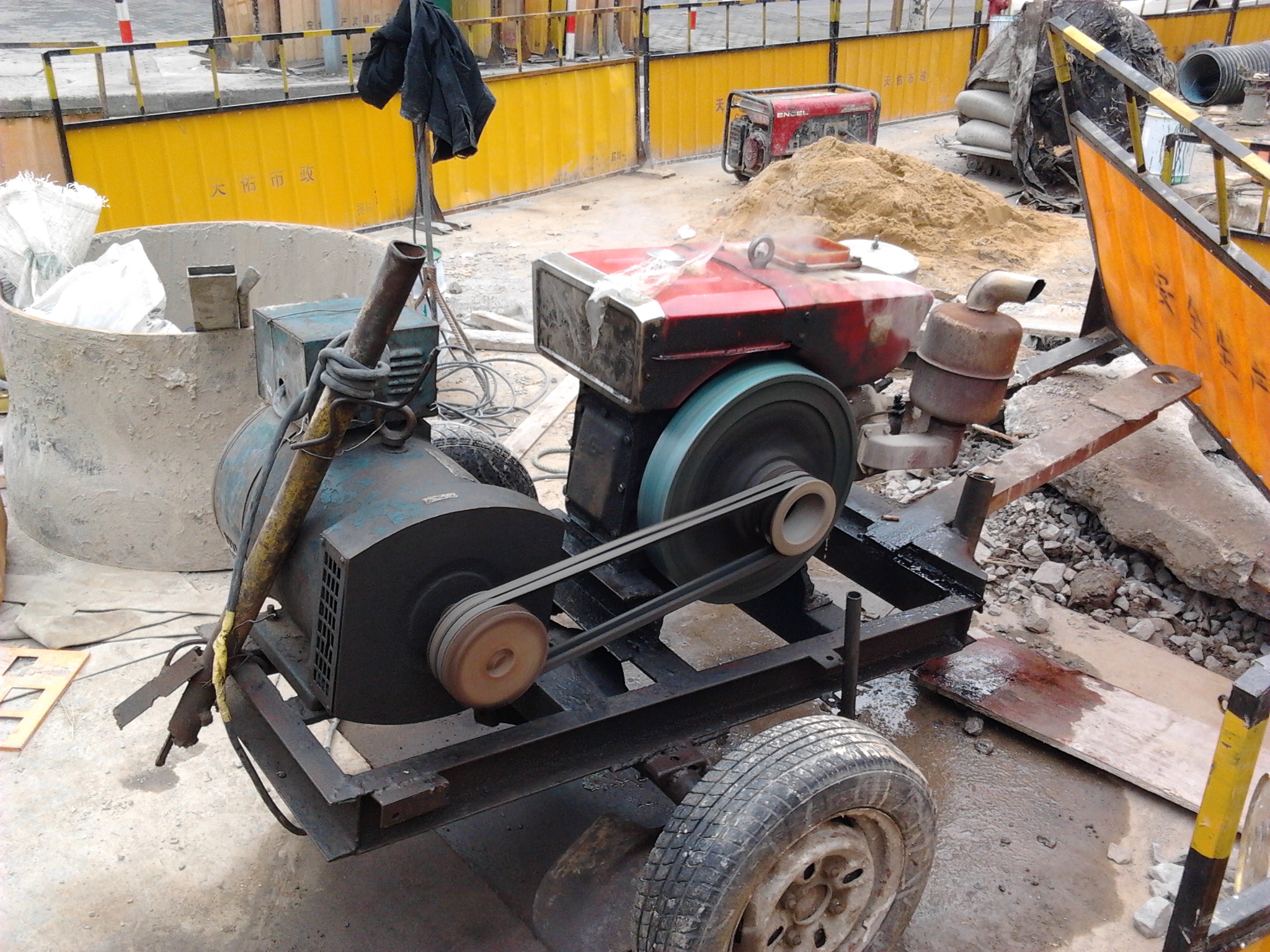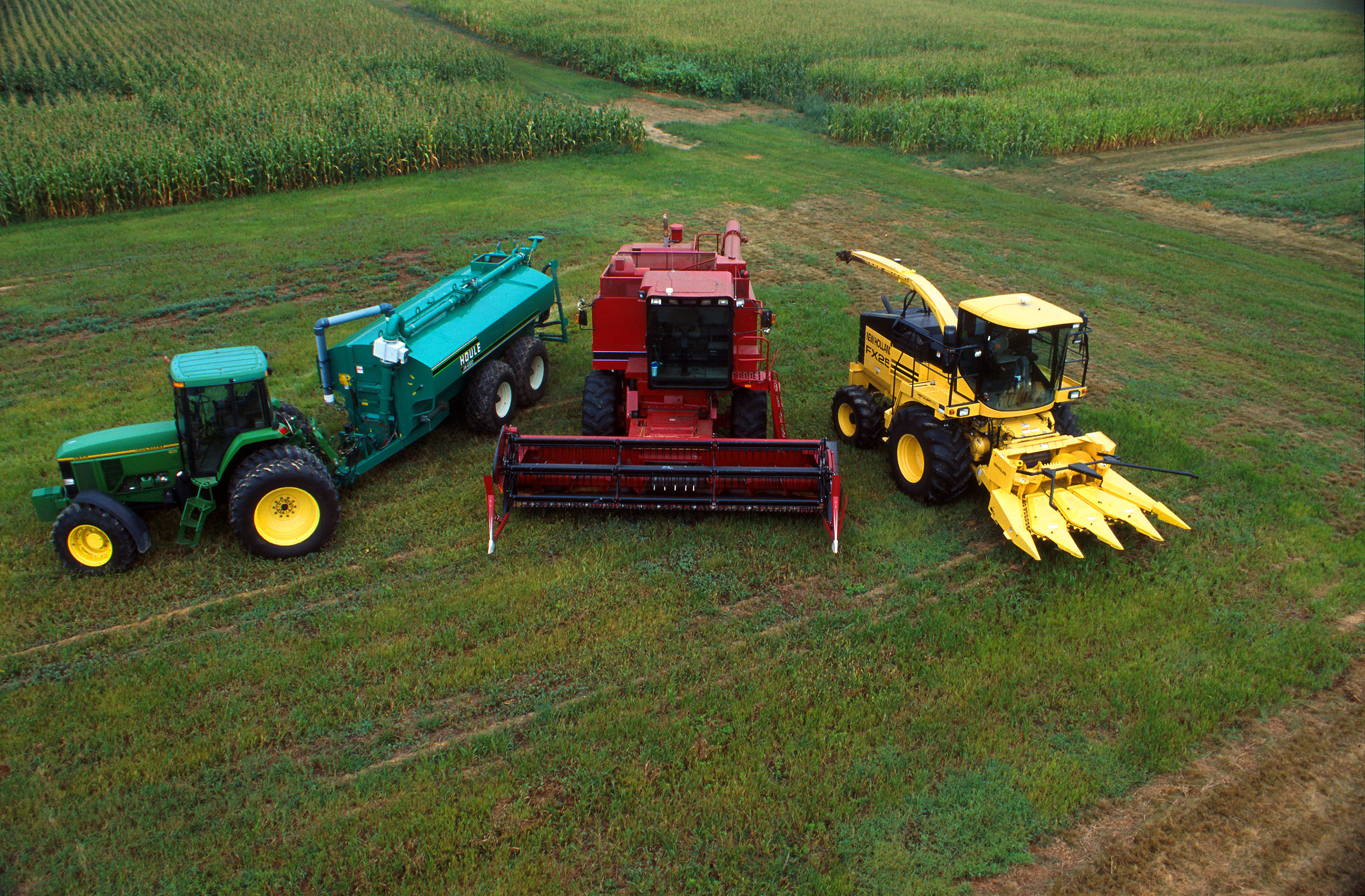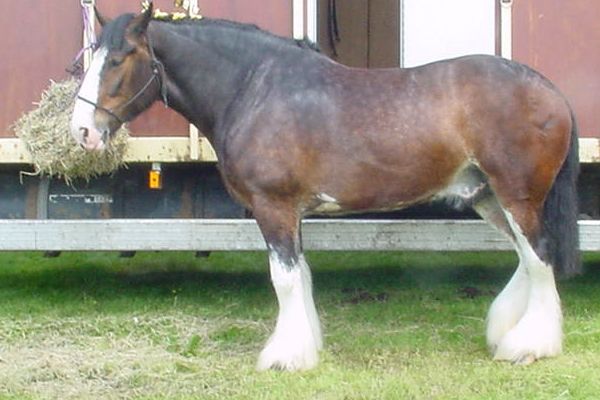|
Portable Steam Engine
A portable engine is an engine, either a steam engine or an internal combustion engine, that sits in one place while operating (providing power to machinery), but (unlike a stationary engine) is portable and thus can be easily moved from one work site to another. Mounted on wheels or skids, it is either towed to the work site or moves there via self-propulsion. Portable engines were in common use in industrialised countries from the early 19th through early 20th centuries, during an era when mechanical power transmission was widespread. Before that, most power generation and transmission were by animal, water, wind, or human; after that, a combination of electrification (including rural electrification) and modern vehicles and equipment (such as tractors, trucks, cars, engine-generators, and machines with their engines built in) displaced most use of portable engines. In developing countries today, portable engines still have some use (typically in the form of modern small engine ... [...More Info...] [...Related Items...] OR: [Wikipedia] [Google] [Baidu] |
Steam Lokomobile 2 (aka)
Steam is a substance containing water in the gas phase, and sometimes also an aerosol of liquid water droplets, or air. This may occur due to evaporation or due to boiling, where heat is applied until water reaches the enthalpy of vaporization. Steam that is saturated or superheated is invisible; however, "steam" often refers to wet steam, the visible mist or aerosol of water droplets formed as water vapor condenses. Water increases in volume by 1,700 times at standard temperature and pressure; this change in volume can be converted into mechanical work by steam engines such as reciprocating piston type engines and steam turbines, which are a sub-group of steam engines. Piston type steam engines played a central role in the Industrial Revolution and modern steam turbines are used to generate more than 80% of the world's electricity. If liquid water comes in contact with a very hot surface or depressurizes quickly below its vapor pressure, it can create a steam explosion. T ... [...More Info...] [...Related Items...] OR: [Wikipedia] [Google] [Baidu] |
Engine-generator
An engine–generator is the combination of an electrical generator and an engine ( prime mover) mounted together to form a single piece of equipment. This combination is also called an ''engine–generator set'' or a ''gen-set''. In many contexts, the engine is taken for granted and the combined unit is simply called a ''generator''. An engine–generator may be a fixed installation, part of a vehicle, or made small enough to be portable. Components In addition to the engine and generator, engine–generators generally include a fuel supply, a constant engine speed regulator (governor) and a generator voltage regulator, cooling and exhaust systems, and lubrication system. Units larger than about 1 kW rating often have a battery and electric starter motor; very large units may start with compressed air either to an air driven starter motor or introduced directly to the engine cylinders to initiate engine rotation. Standby power generating units often include an automatic star ... [...More Info...] [...Related Items...] OR: [Wikipedia] [Google] [Baidu] |
Oil Well
An oil well is a drillhole boring in Earth that is designed to bring petroleum oil hydrocarbons to the surface. Usually some natural gas is released as associated petroleum gas along with the oil. A well that is designed to produce only gas may be termed a gas well. Wells are created by drilling down into an oil or gas reserve that is then mounted with an extraction device such as a pumpjack which allows extraction from the reserve. Creating the wells can be an expensive process, costing at least hundreds of thousands of dollars, and costing much more when in hard to reach areas, e.g., when creating offshore oil platforms. The process of modern drilling for wells first started in the 19th century, but was made more efficient with advances to oil drilling rigs during the 20th century. Wells are frequently sold or exchanged between different oil and gas companies as an asset – in large part because during falls in price of oil and gas, a well may be unproductive, but if pri ... [...More Info...] [...Related Items...] OR: [Wikipedia] [Google] [Baidu] |
Mining
Mining is the extraction of valuable minerals or other geological materials from the Earth, usually from an ore body, lode, vein, seam, reef, or placer deposit. The exploitation of these deposits for raw material is based on the economic viability of investing in the equipment, labor, and energy required to extract, refine and transport the materials found at the mine to manufacturers who can use the material. Ores recovered by mining include metals, coal, oil shale, gemstones, limestone, chalk, dimension stone, rock salt, potash, gravel, and clay. Mining is required to obtain most materials that cannot be grown through agricultural processes, or feasibly created artificially in a laboratory or factory. Mining in a wider sense includes extraction of any non-renewable resource such as petroleum, natural gas, or even water. Modern mining processes involve prospecting for ore bodies, analysis of the profit potential of a proposed mine, extraction of the desire ... [...More Info...] [...Related Items...] OR: [Wikipedia] [Google] [Baidu] |
Sawmill
A sawmill (saw mill, saw-mill) or lumber mill is a facility where logging, logs are cut into lumber. Modern sawmills use a motorized saw to cut logs lengthwise to make long pieces, and crosswise to length depending on standard or custom sizes (dimensional lumber). The Portable sawmill, "portable" sawmill is of simple operation. The log lies flat on a steel bed, and the motorized saw cuts the log horizontally along the length of the bed, by the operator manually pushing the saw. The most basic kind of sawmill consists of a chainsaw and a customized jig ("Alaskan sawmill"), with similar horizontal operation. Before the invention of the sawmill, boards were made in various manual labour, manual ways, either wood splitting, rived (split) and plane (tool), planed, hewing, hewn, or more often hand sawn by two men with a whipsaw, one above and another in a saw pit below. The earliest known mechanical mill is the Hierapolis sawmill, a Roman water-powered stone mill at Hierapolis, Asia ... [...More Info...] [...Related Items...] OR: [Wikipedia] [Google] [Baidu] |
Gristmill
A gristmill (also: grist mill, corn mill, flour mill, feed mill or feedmill) grinds cereal grain into flour and middlings. The term can refer to either the grinding mechanism or the building that holds it. Grist is grain that has been separated from its chaff in preparation for grinding. History Early history The Greek geographer Strabo reports in his ''Geography'' a water-powered grain-mill to have existed near the palace of king Mithradates VI Eupator at Cabira, Asia Minor, before 71 BC. The early mills had horizontal paddle wheels, an arrangement which later became known as the " Norse wheel", as many were found in Scandinavia. The paddle wheel was attached to a shaft which was, in turn, attached to the centre of the millstone called the "runner stone". The turning force produced by the water on the paddles was transferred directly to the runner stone, causing it to grind against a stationary "bed", a stone of a similar size and shape. This simple arrangement required ... [...More Info...] [...Related Items...] OR: [Wikipedia] [Google] [Baidu] |
Threshing Machine
A threshing machine or a thresher is a piece of farm equipment that threshes grain, that is, it removes the seeds from the stalks and husks. It does so by beating the plant to make the seeds fall out. Before such machines were developed, threshing was done by hand with flails: such hand threshing was very laborious and time-consuming, taking about one-quarter of agricultural labour by the 18th century. Mechanization of this process removed a substantial amount of drudgery from farm labour. The first threshing machine was invented circa 1786 by the Scottish engineer Andrew Meikle, and the subsequent adoption of such machines was one of the earlier examples of the mechanization of agriculture. During the 19th century, threshers and mechanical reapers and reaper-binders gradually became widespread and made grain production much less laborious. Michael Stirling is said to have invented a rotary threshing machine in 1758 which for forty years was used to process all the corn on ... [...More Info...] [...Related Items...] OR: [Wikipedia] [Google] [Baidu] |
Agricultural Machinery
Agricultural machinery relates to the mechanical structures and devices used in farming or other agriculture. There are many types of such equipment, from hand tools and power tools to tractors and the countless kinds of farm implements that they tow or operate. Diverse arrays of equipment are used in both organic and nonorganic farming. Especially since the advent of mechanised agriculture, agricultural machinery is an indispensable part of how the world is fed. History The Industrial Revolution With the coming of the Industrial Revolution and the development of more complicated machines, farming methods took a great leap forward. Instead of harvesting grain by hand with a sharp blade, wheeled machines cut a continuous swath. Instead of threshing the grain by beating it with sticks, threshing machines separated the seeds from the heads and stalks. The first tractors appeared in the late 19th century. Steam power Power for agricultural machinery was originally suppli ... [...More Info...] [...Related Items...] OR: [Wikipedia] [Google] [Baidu] |
Steam Tractor
:''This article refers to the steam-powered agricultural tractor; for other types of steam tractor, see: Traction engine'' A steam tractor is a vehicle powered by a steam engine which is used for pulling. In North America, the term ''steam tractor'' usually refers to a type of agricultural tractor powered by a steam engine, used extensively in the late 19th and early 20th centuries. In Great Britain, the term ''steam tractor'' is more usually applied to the smallest models of traction engine - typically those weighing seven tons or less - used for hauling small loads on public roads. Although known as ''light steam tractors'', these engines are generally just smaller versions of the ' road locomotive'. This article concentrates on the steam-powered agricultural vehicles intended for the direct-pulling of ploughs and other implements (as opposed to cable-hauling). Development (Great Britain) Owing to differences in soil conditions, the development of steam-powered agricul ... [...More Info...] [...Related Items...] OR: [Wikipedia] [Google] [Baidu] |
Traction Engine
A traction engine is a steam engine, steam-powered tractor used to move heavy loads on roads, plough ground or to provide power at a chosen location. The name derives from the Latin ''tractus'', meaning 'drawn', since the prime function of any traction engine is to draw a load behind it. They are sometimes called road locomotives to distinguish them from railway steam locomotive, locomotives – that is, steam engines that run on rails. Traction engines tend to be large, robust and powerful, but also heavy, slow, and difficult to manoeuvre. Nevertheless, they revolutionized agriculture and road haulage at a time when the only alternative Prime mover (tractor unit), prime mover was the draught horse. They became popular in industrialised countries from around 1850, when the first self-propelled portable steam engines for agricultural use were developed. Production continued well into the early part of the 20th century, when competition from internal combustion engine-powered ... [...More Info...] [...Related Items...] OR: [Wikipedia] [Google] [Baidu] |
Draft Horse
A draft horse (US), draught horse (UK) or dray horse (from the Old English ''dragan'' meaning "to draw or haul"; compare Dutch ''dragen'' and German ''tragen'' meaning "to carry" and Danish ''drage'' meaning "to draw" or "to fare"), less often called a carthorse, work horse or heavy horse, is a large horse bred to be a working animal doing hard tasks such as plowing and other farm labor. There are a number of breeds, with varying characteristics, but all share common traits of strength, patience, and a docile temperament which made them indispensable to generations of pre-industrial farmers. Draft horses and draft crossbreds are versatile breeds used today for a multitude of purposes, including farming, draft horse showing, logging, recreation, and other uses. They are also commonly used for crossbreeding, especially to light riding breeds such as the Thoroughbred, for the purpose of creating sport horses of warmblood type. While most draft horses are used for driving, ... [...More Info...] [...Related Items...] OR: [Wikipedia] [Google] [Baidu] |
Heyday , a tradition at the University of Pennsylvania
{{disambiguation ...
Heyday may refer to: * Titled works: ** Music: *** ''Heyday'' (The Church album), a 1986 album by the Church *** ''Heyday'' (Fairport Convention album), a 1987 album by Fairport Convention ** ''Heyday'' (novel), a historical novel by Kurt Andersen * Media-production organizations: ** Heyday Books, an independent nonprofit publisher based in Berkeley, California ** Heyday Films, a British film production company ** Heyday Records, an independent record label founded in 1988 by Pat Thomas * Other: ** Heyday (horse) (born 1987) ** Hey Day Students at the University of Pennsylvania enjoy many different events at social gatherings around campus, with some sponsored by the college. Traditions Toast throwing As a sign of school pride, crowds of Quaker fans perform a unique ritual. A ... [...More Info...] [...Related Items...] OR: [Wikipedia] [Google] [Baidu] |
.jpg)







